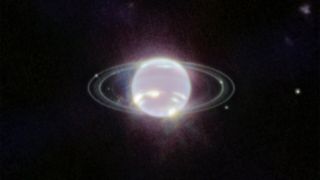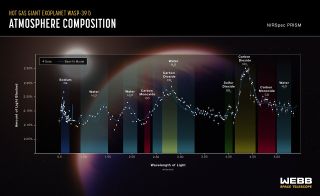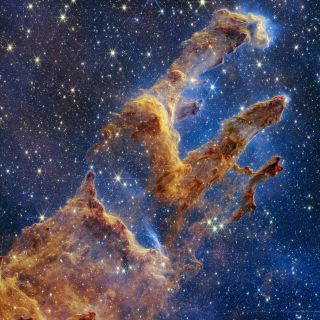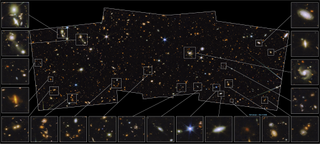James Webb Space Telescope's 1st year in space has blown astronomers away
Astronomers are "amazed" and "blown away" by what JWST has achieved so far.
Just one year after launch, the James Webb Space Telescope is exceeding all expectations, and astronomers are thrilled.
Launched on Dec. 25, 2021, the $10 billion infrared observatory was designed to learn how galaxies form and grow, to peer far back into the universe to the era of the first galaxies, to watch stars be born inside their nebulous embryos in unprecedented detail, and to probe the atmospheres of exoplanets and characterize some of the closest rocky worlds.
However, the complexity of the James Webb Space Telescope (Webb or JWST), including its fold-out, segmented 21-foot (6.5 meters) mirror and its delicate sun-shield the size of a tennis court, meant that astronomers were on tenterhooks as to whether the JWST would perform as hoped.
It turns out, they needn't have worried. "I guess we really weren't expecting the results to be this good," Brenda Frye, an astronomy at Steward Observatory at the University of Arizona, told Space.com.
Related: James Webb Space Telescope's best images of all time (gallery)

"It's amazing," Steve Longmore, an astrophysicist at Liverpool John Moores University in the U.K., told Space.com. "It's delivering at least as well, and better in a lot of circumstances, than what we were expecting."
And if it exceeds its own targets, it definitely surpasses those of its predecessors. "It's leaps and bounds better than what we've been able to see before," Susan Mullally, JWST's deputy project scientist from the Space Telescope Science Institute (STScI) in Maryland, which operates the observatory, told Space.com, adding that she is "blown away by the imagery, honestly. The images are beautiful."
Get the Space.com Newsletter
Breaking space news, the latest updates on rocket launches, skywatching events and more!
The rings of Neptune
The main reason that JWST is performing so well is because of its superlative optics, which are able to achieve their maximum potential resolution for the majority of infrared wavelengths that the telescope observes in. This success means that JWST's images have a clarity to them that were unobtainable by the likes of the Hubble Space Telescope and NASA's retired Spitzer Space Telescope, or larger telescopes on the ground such as those at the Keck Observatory in Hawaii, whose vision is blurred by Earth's atmosphere.
But with JWST, individual stars so close together they were once indistinguishable can now be resolved; the structures of very distant galaxies are now discernible; and even something close by such as the rings of Neptune pop with the most detail seen in decades.

"When the JWST's images of Neptune first came out, both Heidi [Hammel, an interdisciplinary scientist on JWST and an expert on the outer planets of the solar system] and myself looked at them, and then at each other, and asked, 'are we really looking at Neptune'?" Naomi Rowe-Gurney, an astronomer at NASA Goddard Space Flight Center in Maryland, told Space.com.
Although the Keck Observatory has imaged Neptune's rings, our most impressive view before JWST came from Voyager 2's flyby in 1989. "Heidi had not seen the rings [this well] since Voyager 2, and I had never seen the rings like this because Voyager was before I was born!" Rowe-Gurney said.
Normally, faint details or features around a bright object, such as the dark and tenuous rings around blue Neptune, are difficult to see against the glare of the bright object. To counteract this, an instrument is required to have the characteristic of "high dynamic range" to take in both the faint and the bright at the same time.
"We didn't realize that JWST would have this amazing dynamic range and be able to resolve really faint things like the rings of Neptune and the small moons and rings of Jupiter," Rowe-Gurney said.
Alien atmospheres
It's not only the planets of our solar system that JWST is scrutinizing. A key aim of the telescope is to detect the composition of exoplanets' atmospheres using a technique called transmission spectroscopy. As a planet transits its star, the star's light shines through the planet's atmosphere, but atoms and molecules within that atmosphere can block some of the light at characteristic wavelengths, which gives away the composition of the atmosphere.
The first exoplanet result released from JWST was the transmission spectrum of WASP-39b, which is a "hot Jupiter" exoplanet orbiting a sun-like star located 700 light-years away. JWST detected carbon dioxide in WASP-39b's atmosphere, the first time the gas has ever been detected on an exoplanet. Other gases present included carbon monoxide, potassium, sodium, water vapor and sulfur dioxide, the last of which can only be created through photochemistry when atmospheric gases react with the ultraviolet light from the planet's star — another exoplanet first.

"I keep being amazed by what we're able to do with the exoplanet data, like the carbon dioxide and the photochemistry that was found in the atmosphere of WASP-39b," Mullally said. "That was really cool, and I don't remember people talking about [detecting photochemistry] ahead of time. I'm really looking forward to seeing what we can do with the terrestrial exoplanets orbiting the cool M-dwarfs and seeing what their atmospheres are made of."
In particular, the TRAPPIST-1 planetary system of seven worlds orbiting an M-dwarf 40 light-years away is a key target of the JWST. Preliminary results, which failed to detect thick blankets of hydrogen surrounding some of the TRAPPIST-1 worlds, were released during a conference held at STScI in December, but we'll have to be patient for more comprehensive results from these planets, of which up to four could reside in their star's habitable zone.
WASP-39b was an easy first target because its star is bright and the planet's signal is strong. M-dwarfs like TRAPPIST-1 are much fainter, despite being closer.
"We have to wait until we can get enough transits of these guys to build up the signal-to-noise, because you can't do it with just one or two transits," Mullally said. "I think we're going to have to wait until at least the end of the cycle 1 observations [summer 2023] before anybody is going to be in a position to say if they've found anything really spectacular."
Star formation near and far
Another aspect of JWST's mission is to not only observe exoplanets, but to better understand how they, and their stars, form. Star formation in particular is a crucial process to understand it because it connects so many things in the universe both near and far.
Longmore is leading a study to use JWST to observe frantic star formation in a region at the center of our own Milky Way galaxy, called the central molecular zone, some 26,000 light-years from us. The center of our galaxy hosts the highest concentration of stars, and at our distance they all appear packed in — indistinguishable to the likes of the Hubble Space Telescope — while copious amounts of dust shroud most of them from view in optical light. Look with a large-aperture infrared telescope like JWST, however, and those two concerns are shoved aside.
"These are the JWST's two capabilities that are going to blow my field apart," Longmore said. The telescope's superb optics are able to resolve individual baby stars in the center of the galaxy, and infrared light will pass right through the dust to reach the observatory.
"Ordinarily, with Hubble, it's like trying to point your telescope at a brick wall and see through it," he added, "But the JWST is looking through a window in that wall and can count individual stars."

It's taking longer to gather all the data from the center of the galaxy, but that's because it's such a complex environment, with bright, diffuse emission everywhere, and all that has to be disentangled from the relevant signal of star formation via determined and careful data processing.
"On all the projects I'm on, people are still fighting with calibration and things, but hopefully in the next six months that will change," Longmore said. He added an amusing story of how one of his team's observations had been blighted by a mysterious circle on the image. After deeper investigation, it turned out that this wasn't some mysterious new phenomenon, but that JWST had previously been looking at bright Jupiter, and the giant planet's after-image had not yet been properly flushed out of the instrument's electronic sensors!
Longmore and his colleagues are targeting the central molecular zone because it is the region in our galaxy that most resembles star-forming conditions in the early universe, when the star-formation rate was high and dense clusters of stars formed. In the Central Molecular Zone, the astronomers intend to measure a property called the initial mass function (IMF), which describes the range of stellar masses in a star-forming nebula.
Currently, astronomers do not understand what determines why stars form with the masses that they have, only that low-mass stars are much more common than luminous high-mass stars, at least in the local universe. Was this still the case over 13 billion years ago in the first galaxies? Answering that question could help explain both how galaxies formed and what ended the universe's dark ages.
Deep fields and the first galaxies
After she saw President Joe Biden reveal the first deep-field image from the JWST, of the galaxy cluster SMACS 0723, a "gravitational lens" whose massive gravity magnifies objects behind it, Frye and her student, Massimo Pascale at the University of California, Berkeley, raced to analyze the image.
"We didn't sleep for three-and-a-half days, and our paper was one of the first two papers submitted on JWST data," Frye said.
Together, they found 42 new gravitationally lensed images of 14 different high-redshift galaxies, galaxies located so far away that the expanding universe has stretched their light, making them appear redder. Further studies and more deep fields followed, and a host of high-redshift candidates were discovered by Frye's team and others, including some galaxies at record-breaking redshifts of 12, 13 and above; these redshifts mean that we see the galaxies as they existed less than 300 million years after the Big Bang.
These high-redshift galaxies have proven something of a surprise, in that they appear more luminous than models of galaxy formation predicted they should be.
"One possible explanation is that they're producing too many high-mass stars, that they have a top-heavy IMF," Longmore said, noting the importance of measuring the IMF in the central molecular zone to understand stellar masses in young neighborhoods.
Why the IMF would be different over 13.5 billion years ago is not understood, but then again the early universe seems to have been a far more intense place than it is today. "In the present day, galaxies in general are not forming stars so actively, but many galaxies formed stars more actively in the early universe," Frye said.
Frye is a member of the PEARLS (Prime Extragalactic Area for Reionization and Lensing Science) team. PEARLS is a JWST project to image a variety of deep fields, including two apparently sparse regions of sky and a number of galaxy clusters and proto-clusters, to observe the first few billion years of galaxy formation.

In December, the PEARLs team released their first dataset, of an extraordinary field of distant galaxies close to the North Ecliptic Pole. This region is directly above the main plane of the Milky Way and so is constantly visible to JWST, and it's also high above interfering features such as zodiacal dust.
Within the image are a whole host of galaxies. Some interact and some show a clear spiral structure; the collection exhibits a whole range of colors, from cobalt blue to ruby red. The latter are of great interest to Frye.
"We can now observe [in the PEARLS image] an abundance of red disk galaxies, which we think might be red spirals," Frye said. "This type of galaxy is very interesting because they are analogs of what the Milky Way might have looked like when it was younger."
The reddening is caused by huge amounts of dust in these galaxies; the dust is the result of rapid formation of massive stars that quickly die in supernova explosions and spill vast amounts of dust into space. Such galaxies are completely hidden from Hubble, but infrared light can pass through the dust and make the galaxies visible to JWST.
"The analogy is a New Year's Eve fireworks display," Frye said. "If you have a lot of fireworks going off then eventually they are obscured by dusty smoke."
The JWST has impressed scientists in the six months that it has been gathering data since becoming fully operational in June, but the real fireworks are still to come with major discoveries awaiting us.
It's slow going, requiring patience, Frye said. "There's too much for any one person to be able to study or understand on really short timescales, it's going to take us a long time to process all the data."
The results, though, will be worth it.
"It's going to completely change our understanding of our place in the universe, how the solar system formed and evolved, and how the very first stars and galaxies formed," Mullally said. "We've made great headway with this telescope, and it's going to do spectacular things."
Follow Keith Cooper on Twitter @21stCenturySETI. Follow us on Twitter @Spacedotcom and on Facebook.
Join our Space Forums to keep talking space on the latest missions, night sky and more! And if you have a news tip, correction or comment, let us know at: community@space.com.

Keith Cooper is a freelance science journalist and editor in the United Kingdom, and has a degree in physics and astrophysics from the University of Manchester. He's the author of "The Contact Paradox: Challenging Our Assumptions in the Search for Extraterrestrial Intelligence" (Bloomsbury Sigma, 2020) and has written articles on astronomy, space, physics and astrobiology for a multitude of magazines and websites.
